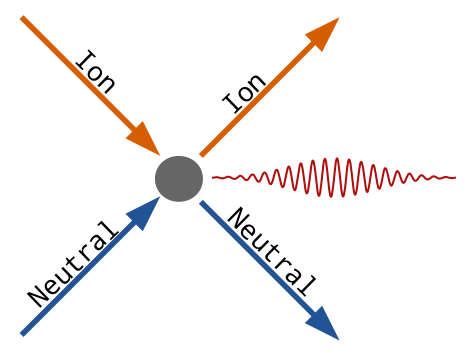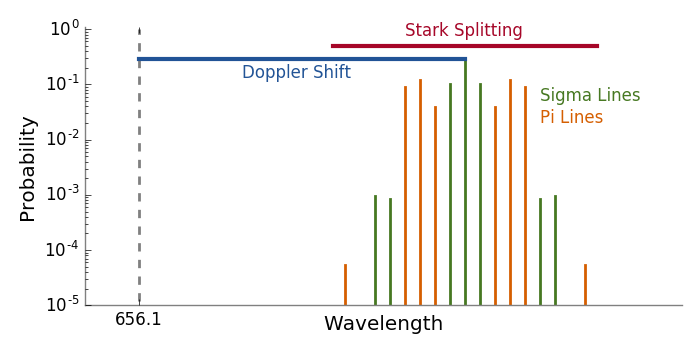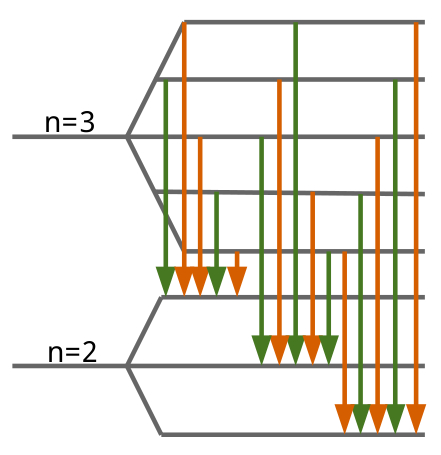Spectra
Spectroscopic Geometry
The spectroscopic geometry is defined similarily to the neutral beam.
It is defined by the lens position in machine coordinates and an optical axis.
The volume of the sightline is assumed to be cylindrical with radius, spot_size.
If mirrors are present then the apparent positions of the lens as seen from the plasma are used.
Additionally, mirrors reflect the sigma and pi Stark lines differently due to a difference in polarization.
The experimentally determined ratio of the intensties of the sigma and pi lines, sigma_pi, is used to correct for this.
If there are no mirrors then sigma_pi is set to 1.0 .
The full geometry specification is given below.
| Variable | Type | Rank | Dimensions | Units | Description |
|---|---|---|---|---|---|
nchan |
Int32 | 0 | NA | NA | Number of channels |
system |
String | 0 | NA | NA | Name of the spectrocopic system(s) |
data_source |
String | 0 | NA | NA | Source of the spectral geometry data |
id |
String | 1 | [nchan] |
NA | Channel ID |
radius |
Float64 | 1 | [nchan] |
cm | Line of sight radius at midplane or tangency point |
lens |
Float64 | 2 | [3,nchan] |
cm | Lens location in machine coordinates |
axis |
Float64 | 2 | [3,nchan] |
NA | Optical axis/direction of the lines of sight |
spot_size |
Float64 | 1 | [nchan] |
cm | Radius of the collecting volume |
sigma_pi |
Float64 | 1 | [nchan] |
NA | Ratio of the intensities of the sigma and pi stark lines |
Types of Spectra
FIDASIM can calculate the following spectra
- Bremsstrahlung
- Beam Emission (BES: Full, Half, Third)
- Halo Emission
- Thermal Ion direct charge exchange (DCX)
- Fast-ion D- (active and passive FIDA)
- Cold D-

Bremsstrahlung
The largest source of background emission is visible bremsstrahlung. The local bremsstrahlung emissivity per unit wavelength is given by
where is the wavelength in angstroms, is the electron density in , is the electron temperature in eV. The gaunt factor, , depends on and . It can be approximated by
To calculate the total emission "seen" by the line of sight the the local emissivity is integrated over the line of sight.
Emission by Neutrals
There are two processes in which neutrals can emit light: Excitation and Charge Exchange.


Excitation is the primary method in which beam neutrals emit light (BES). In short, a neutral particle collides with a charged particle, exciting into a higher energy () state. When the neutral particle relaxes () it emits a doppler shifted (656.1 nm) photon.
Charge Exchange is the process by which the Halo and FIDA light is created. In a charge exchange reaction a thermal (DCX, Halo) or fast (FIDA) ion steals an electron from a neutral particle. The newly created neutral is born in an excited ( state and like the collisionally excited neutral it relaxes to a lower energy state (\n=2) and emits a doppler shifted (656.1 nm) photon.

 The motion of a ion in a magnetic field induces an electric field which causes Stark Spitting of the the atoms energy levels.
Most atoms the strength of the Stark effect is quadratic in low electric fields and linear for strong electric fields.
Usually atoms never the linear regime but, due to degenerency between states of different angular momentum, hydrogenic atoms exhibit a linear Stark effect.
The linear Stark energy component shifts are given by the following equations.
The motion of a ion in a magnetic field induces an electric field which causes Stark Spitting of the the atoms energy levels.
Most atoms the strength of the Stark effect is quadratic in low electric fields and linear for strong electric fields.
Usually atoms never the linear regime but, due to degenerency between states of different angular momentum, hydrogenic atoms exhibit a linear Stark effect.
The linear Stark energy component shifts are given by the following equations.
As seen from the above equation, each energy level is split into parts. For the Balmer-alpha transition, this creates 15 distinct transitions from the state.
The relative intensity of the different Stark lines is given by
where positive and negative sums refer to and lines respectively and are the calculated relative Stark intensities for each transition given by
Relevant Namelist Settings
calc_bes: Calculate NBI spectra (approximate calculations if neutrals are loaded, i.e., load_neutrals=1)calc_dcx: Calculate DCX spectra (approximate calculations if neutrals are loaded, i.e., load_neutrals=1)calc_halo: Calculate Halo spectra(approximate calculations if neutrals are loaded, i.e., load_neutrals=1)calc_cold: Calculate Cold D-alpha spectracalc_brems: Calculate Bremsstrahlungcalc_fida: Calculate FIDA spectracalc_pfida: Calculate pFIDA spectracalc_fida_wght: Calculate FIDA weight function and emission using the weight function methodn_fida: Number of Monte Carlo particles used in FIDA spectra calculationn_pfida: Number of Monte Carlo particles used in passive FIDA spectra calculationn_nbi: Number of Monte Carlo particles used in NBI spectra calculationn_halo: Number of Monte Carlo particles used in Halo spectra calculationn_dcx: Number of Monte Carlo particles used in DCX spectra calculationn_birth: Number of Monte Carlo particles used in BIRTH calculationnlambda: Number of wavelength binslambdamin: Minimum wavelength [nm]lambdamax: Maximum wavelength [nm]nlambda_wght: Number of wavelength bins for weightslambdamin_wght: Minimum wavelength for weights [nm]lambdamax_wght: Maximum wavelength for weights [nm]
Fortran References
- bremsstrahlung: Calculates Bremsstrahlung
- spectrum: Calculates Doppler shift and Stark splitting.
- ndmc: Calculates BES spectra
- dcx: Calculates DCX neutrals contribution to the DCX spectra
- halo: Calculates thermal neutrals contribution to the Halo Spectra
- fida_f: Calculates FIDA light using a distribution function
- fida_mc: Calculates FIDA light using a particle distribution